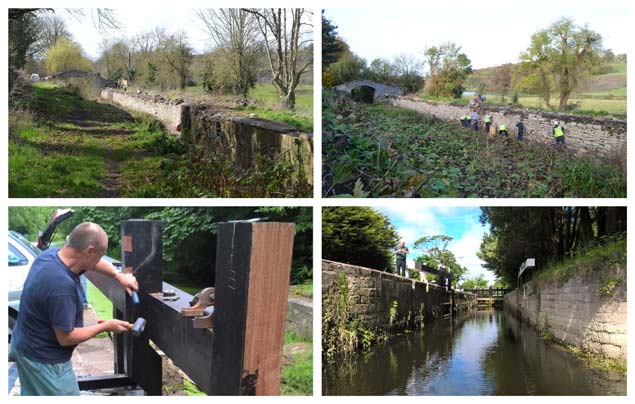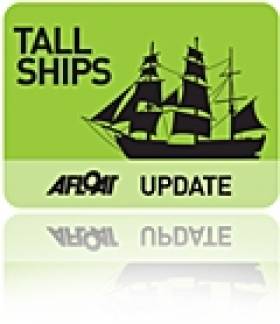Displaying items by tag: Drogheda Maritime Festival
Water Wags Mark the Restoration of the Boyne Canal at Irish Maritime Festival in Drogheda
15 years of dedicated voluntary work by the Boyne Navigation Branch, part of Inland Waterways Association of Ireland, will be celebrated at the Irish Maritime Festival in Drogheda next week.
For many years the Boyne Canal had been closed to vessels. Originally a transport route for bringing cargo and produce to Drogheda Port from Navan, the development of the railways in the early 1900’s saw the demise of river transport. By 1932 the Boyne Canal gates were decaying and sealed up.
Over the past 15 years, a small but dedicated team of Boyne Navigation Branch volunteers, have been working to re-open the channel of the Boyne that leads up to the historic Oldbridge House (site of the Battle of the Boyne). This has been a labour of love requiring both investment and many, many hours of hard graft by these highly-skilled volunteers.
 Restoration of the Boyne Canal
Restoration of the Boyne Canal
The photos indicate the abandoned state of the canal when they started, the craftsmanship of their restoration work and the beautiful amenity that they’ve created for locals and visitors alike.
Through their efforts, the Boyne Canal is gradually re-opening to small vessels, both sail and motor.
To celebrate, the Water Wags are coming to Drogheda as part of next weekend’s Irish Maritime Festival. The concept for the Wags came from Dublin lawyer Thomas Middleton over 130 years ago. His idea of building a fleet of identical light weight sailing boats to race in Dublin Bay was coming to fruition at the same time that the Boyne Canal was in its heyday.
The Wags will set out from the Boyne Fisherman’s Rescue on Saturday morning, sail through Drogheda and will then approach the Boyne Canal in a procession. The sailors will disembark for a visit to Oldbridge House before sailing back down the river after the Boyne Swim. On Sunday the Water Wags will sail in a Regatta on the River Boyne to delight the festival going audience.
The invitation to the Water Wags to visit Drogheda is an initiative of Drogheda Port Company and Louth County Council. It is facilitated by the teams at the Boyne Navigation Branch (IWAI), Boyne Fisherman’s Rescue and the Office of Public Works.
Colette Moss of Louth County Council explains “Louth County Council and Drogheda Port Company, in conjunction with local groups, are working hard to extend our offering to sailors. Last year we opened Fiddle Case Pier in Drogheda, allowing leisure sailors to visit Drogheda for daytrips and overnights.”
Drogheda’s Harbourmaster Capt. Martin Donnelly continues “The new slipway at the ramparts and the opening up of the Boyne Canal makes the river accessible to smaller vessels. Ultimately the Boyne Branch of the IWAI want to make both Oldbridge and Newgrange accessible by boat from the Irish Sea. We commend their tireless, dedicated work in restoring the Boyne Canal.”
Capt. Donnelly concludes “The River Boyne is one of Drogheda’s greatest attributes and we’re proud to use the Irish Maritime Festival to showcase these features to the sailing community and invite them to discover our town and the Boyne Valley region.”
The Irish Maritime Festival takes place on Saturday 16th and Sunday 17th June and is hosted by Louth County Council in conjunction with Drogheda Port Company. The Festival is proudly sponsored by Virgin Media and supported by Flogas, Glanbia and Fáilte Ireland. For more information visit www.MaritimeFestival.ie
#SailBessie – A fantastic opportunity to sail on a voyage to Drogheda to coincide with the maritime festival, is to see the 1904 built West Country trading ketch, Bessie Ellen set forth from Scotland on 7 June, writes Jehan Ashmore.
The 110 year-old lady, Bessie Ellen, will take in a seven-day voyage involving stunning scenery and famous landmarks along the way between the embarkation port in Oban and the mountains of Mull, Jura and Islay.
There may even be an en-route port of call to Northern Ireland or the Isle of Man, which could include a visit to a quirky port and an anchorage offshore to a secluded place you may not have heard of.
Bessie Ellen will then head for the second Drogheda Maritime Festival (13,14 and 15 June) as previously reported and where in total five tall ships are expected to gather.
If this whets your appetite to take a classic journey under sail and a chance to realise an ambition to step back in time on board a timber-built trading vessel then the Bessie Ellen is for you. She is only one of three surviving West Country ketches from more than 600 built as cargo-carrying vessels trading in the Irish Sea and northern Europe.
Interestingly, in recent years she has carried commercial wine-cargoes as she still holds a licence for present day small cargo-handling.
For example the French-owned Fair Wind Wine had chartered the vessel Bessie Ellen during the final Dublin Docklands Maritime Festival in 2010 for public wine-tasting! See below photo of the ketch during that festive occasion.
Also attending the what would become the final Dublin Docklands Development Authority (DDDA) organised festival was the French 'gabre' or trading vessel, Notre Dame de Romengol, a somewhat trawler-like looking craft.
So if you are interested in traditional sailing vessels offering sailing holiday voyages for 12 people and you have a zest for 'hands on' adventure why not become a crew member of Bessie Ellen.
West Country ketch Bessie Ellen during the final DDDA Docklands Maritime Festival in 2010. Photo Jehan Ashmore
With that in mind, the final leg will be from the mouth of the Boyne and heading upriver to be greeted at the Louth port as part of the Drogheda Maritime Festival. For further details and on prices, visit Classic Sailing's website HERE and above to hear her owner, Nikki Alford talk about her sailing holidays.
In addition to further updates on the Maritime Festival posted on Drogheda Port Company website.































































